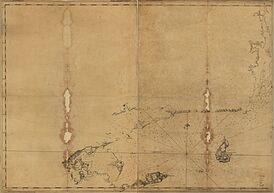Buttonwoods Beach Historic District facts for kids
Quick facts for kids |
|
|
Buttonwood Beach Historic District
|
|
 |
|
| Location | Warwick, Rhode Island |
|---|---|
| Architect | Multiple |
| Architectural style | Late 19th And 20th Century Revivals, Late Victorian |
| MPS | Warwick MRA |
| NRHP reference No. | 84001834 |
| Added to NRHP | February 23, 1984 |
The Buttonwood Beach Historic District is a special area in Warwick, Rhode Island. It's a historic neighborhood known for its beautiful coastal views. This district is bordered by Brush Neck Cove, Greenwich Bay, Cooper Avenue, and Promenade Avenue.
Buttonwood Beach started as a summer getaway in 1871. A minister named Moses Bixby wanted to create a peaceful summer community. He imagined a place like Oak Bluffs on Martha's Vineyard. Today, this lovely area by Greenwich Bay is home to many families. The district was added to the National Register of Historic Places in 1984. This means it's recognized for its important history.
Contents
Exploring Buttonwood Beach History
For over 200 years, Buttonwoods was mostly farmland. The Budlong and Greene families settled here around 1700. Their homes are some of the oldest still standing in Warwick. Early American Indian families also lived here.
Early Days and Public Beach Fun
By the 1830s, the Kinnecom family, who were American Indian residents, opened Buttonwoods Beach to the public. It became a popular spot for clambakes and beach trips. People loved coming here to enjoy the shore.
An old British map from 1779 shows these early homes. It also shows Buttonwoods Avenue, a road connecting the settlements. This road is still used today.
The Vision of Moses Bixby
Reverend Moses Bixby was a Christian missionary before founding Buttonwoods. He spent ten years in Burma and Siam. He even met the King of Siam in 1862. Bixby helped teach English to people there.
When Bixby returned in 1870, he partnered with Lodowick Brayton. Brayton was a successful businessman. Together, they bought land in Warwick for $10,000. This was a huge amount of money back then. They planned to sell over 1,000 lots for a summer community.
The area became very popular. People would travel by steamboat or wagon to visit. In the 1830s, the Kinnecom family hosted huge clambakes. They even hosted a political rally for William Henry Harrison. Over 10,000 people attended this event! The area was named "Buttonwoods" because of the many buttonwood trees.
Growth and Development
The plan for Buttonwoods was to sell land to Baptist families. However, a financial crisis in 1873 slowed sales. Many lots remained unsold for years. Later, the lots were made larger.
Another key investor was Andrew Comstock. He was a successful beef merchant. These partners wanted to build a rail link to the shore. A horse railway was first built, then steam trains. This railway connected Buttonwoods to other areas. It operated until 1936.
In the early 1900s, Buttonwoods got street lighting. The Buttonwood Beach Association asked the town for lights in 1903. This made the streets public highways.
What Buttonwood Beach Looks Like Today
Buttonwood Beach is a small residential neighborhood. It has about 170 houses. Many homes are historic, with Victorian cottages and larger bungalows. These bungalows are in the Arts and Crafts style. The streets are lined with many old trees.
Some of the original cottages are still standing. However, others have been torn down over the years. This includes the Moses Bixby cottage.
Nearby Attractions
Across Buttonwoods Cove is Warwick City Park. This park has baseball fields, picnic areas, and bike paths. It also has tennis courts and other fun things to do.
Next to Old Buttonwoods is Budlong Farm. This farm is home to the Buttonwoods Campers Association. This summer colony started around 1900. The Budlong and Greene families were among Warwick's first settlers.
The original Greene/Budlong farm home, built in 1776, is still there. It can be seen from Buttonwoods Avenue. The Buttonwoods Campers Association now has 120 cottages. They continue to lease the land for summer fun.
Buttonwood Beach Association
The Buttonwood Beach Association (BBA) was created in 1872. It was formed to manage the summer resort. Property owners in Buttonwoods can be members.
The BBA organizes activities and celebrations for residents. Many events are held at the "Casino" building. This building has a stage and bowling alleys. There are also tennis courts and a playground nearby. The BBA also built a chapel for everyone to use.
Buttonwoods Fire District
The Buttonwoods Fire District was formed in 1925. It acts like a local government for the area. It's separate from the City of Warwick.
The Fire District maintains public streets, parks, and seawalls. They use taxes collected from property owners for this. They also maintain recreational facilities like the Casino and tennis courts. These facilities are for residents only. The Fire District also takes care of storm drains.
The streets in Buttonwoods are public. This means they are open for everyone to use. The Fire District helps keep them in good condition.
The Buttonwoods Campers Association still leases land today. They have a community hall for social events. They've added a basketball court, volleyball court, and playground. Even with some beach erosion, families still enjoy summers here.
The Budlong Farm land is now protected. It won't be developed. It remains a beautiful reminder of colonial times.
Images for kids






